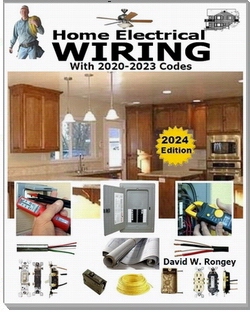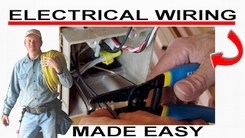» Need Electrical Help? Ask the Electrician
Electrical Wiring Inspections
 |
Summary: This Home Electrical Wiring Safety Checklist will help you protect your home, your family, and your life.
© By: Dave Rongey |
How to Identify Potential Home Electrical Wiring Hazards
This article will help you to identify some of the most potential home electrical wiring hazards.
Identifying and correcting any potential hazards will ensure safety for you and your home and could also raise the value of your home.
Identify Potential Home Electrical Wiring Hazards
Professional Inspections and Corrective Measures
Here are some areas of home electrical systems that require professional inspection.
[ ] The bonded grounding system of the main electrical service. Grounding makes the system work safely and it can help prevent electrocution in homes that have three prong grounding-type outlets. The round hole accepts the grounding prong for appliance plugs and other devices.
[ ] Smoke Detectors. Upgrade to interconnected hard wired smoke detectors with battery back-up power. The important feature is that when one goes off, they all go off, and that will alert everyone.
[ ] Ground Fault Circuit Interrupter (GFCI)
Older homes may not have grounding-type outlets. If that's the case, the old two-hole outlets can be replaced with a device is known as a Ground Fault Circuit Interrupter or GFCI which provides the best protection against electrocution. The GFCI does not need grounding but still provides a superior job of stopping electrical shock. Electrocution protection is especially important in the case of appliances with metal parts in rooms such as laundry, kitchen or bathrooms where water is used and the danger of shock is great.
[ ] In older homes with original electrical systems all fixtures and wiring lead back to a fuse box or circuit breaker panel. In some fuse boxes, there may be too many circuits connected to one fuse. Older fuse boxes may have corroded connections, unplugged holes or missing panel doors. Your electrician can install a new electrical panel that uses circuit breakers with more circuits available for large appliances such as a clothes dryer, electric range or an air conditioner.
[ ] The added advantage of a built-in surge suppressor would helps protect appliances against lightning or power surges.
[ ] Arc Fault Circuit Interrupter (AFCI)
Let’s look at the newly developed electrical safety features of the arc fault circuit interrupter, or AFCI. Whereas GFCI’s can protect you from electrocution, an AFCI can protect you from a deadly electrical fire. Arc faults occur when electricity jumps from wire to wire, and can happen when wires or fixtures are damaged or have deteriorated over time. These arcs generate high temperatures which can ignite nearby combustible materials such as wood, paper or home furnishings. The AFCI, which can be installed in place of a conventional circuit breaker, minimizes this risk by detecting these faults as they occur, cutting the power to the circuit, and removing the heat source that can lead to a fire.Where to Begin to be Safer:
If you can't afford to improve your electrical system all at once, do it in stages.[ ] Fix the most dangerous problems first. Look into a home improvement loan to spread out the cost over time.
Last but not least:
Ask your insurance agent if your safety improvements qualify you for a reduction in premiums.
Taking care of your electrical system will make your home a safer place to live.
Remember, electrical systems in your house won't last forever. They need to be maintained just like your car, your furnace, your roof or your chimney.
It's well worth the effort to have a professional check your home electrical system for safety. It will provide you with a feeling of safety.
|
||||||||
| <<- Home Improvement Electrical Wiring | Home Improvement Electrical Considerations->> |
| Home Electrical Wiring Inspections Top of Page - |
The Safest Way to Test Electrical Devices and Identify Electric Wires!The Non-Contact Electrical TesterThis is a testing tool that I have had in my personal electrical tool pouch for years, and is the first test tool I grab to help identify electrical wiring. It is a Non-contact tester that I use to easily Detect Voltage in Cables, Cords, Circuit Breakers, Lighting Fixtures, Switches, Outlets and Wires. Simply insert the end of the tester into an outlet, lamp socket, or hold the end of the tester against the wire you wish to test. Very handy and easy to use.
The Quickest Way to Check for Faulty Electrical Wiring!The Plug-In Outlet TesterThis is the first tool I grab to troubleshoot a problem with outlet circuit wiring. This popular tester is also used by most inspectors to test for power and check the polarity of circuit wiring. It detects probable improper wiring conditions in standard 110-125 VAC outlets Provides 6 probable wiring conditions that are quick and easy to read for ultimate efficiency Lights indicate if wiring is correct and indicator light chart is included Tests standard 3-wire outlets UL Listed Light indicates if wiring is incorrect Very handy and easy to use.
Strip Off Wire Insulation without Nicking and Damaging the Electric Wire!The Wire Stripper and Wire CutterMy absolute favorite wire stripping tool that I have had in my personal electrical tool pouch for years, and this is the tool I use to safely strip electrical wires. This handy tool has multiple uses: The wire gauges are shown on the side of the tool so you know which slot to use for stripping insulation. The end of the tool can be used to grip and bend wire which is handy for attaching wire onto the screw terminals of switches and outlets.. The wire stripper will work on both solid and stranded wire. This tool is Very Handy and Easy to Use. |
||
Residential Electrical Parts and AccessoriesLight Switches 120volt Outlets Circuit Breakers Electrician Tools Voltage Testers |
| Questions and Answers about Electrical Inspection |
The Safest Way to Test Electrical Devices and Identify Electric Wires!The Non-Contact Electrical TesterThis is a testing tool that I have had in my personal electrical tool pouch for years, and is the first test tool I grab to help identify electrical wiring. It is a Non-contact tester that I use to easily Detect Voltage in Cables, Cords, Circuit Breakers, Lighting Fixtures, Switches, Outlets and Wires. Simply insert the end of the tester into an outlet, lamp socket, or hold the end of the tester against the wire you wish to test. Very handy and easy to use.
The Quickest Way to Check for Faulty Electrical Wiring!The Plug-In Outlet TesterThis is the first tool I grab to troubleshoot a problem with outlet circuit wiring. This popular tester is also used by most inspectors to test for power and check the polarity of circuit wiring. It detects probable improper wiring conditions in standard 110-125 VAC outlets Provides 6 probable wiring conditions that are quick and easy to read for ultimate efficiency Lights indicate if wiring is correct and indicator light chart is included Tests standard 3-wire outlets UL Listed Light indicates if wiring is incorrect Very handy and easy to use.
Strip Off Wire Insulation without Nicking and Damaging the Electric Wire!The Wire Stripper and Wire CutterMy absolute favorite wire stripping tool that I have had in my personal electrical tool pouch for years, and this is the tool I use to safely strip electrical wires. This handy tool has multiple uses: The wire gauges are shown on the side of the tool so you know which slot to use for stripping insulation. The end of the tool can be used to grip and bend wire which is handy for attaching wire onto the screw terminals of switches and outlets.. The wire stripper will work on both solid and stranded wire. This tool is Very Handy and Easy to Use. |
||
Residential Electrical Parts and AccessoriesLight Switches 120volt Outlets Circuit Breakers Electrician Tools Voltage Testers |















